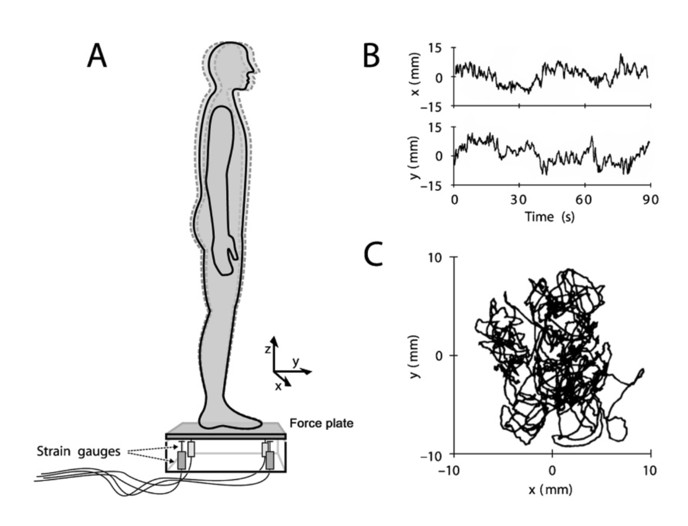A large variety of force-time derivatives (e.g., mass, sway distance, sway velocity, entropy) can be calculated from time-series data. This article provides a general explanation of what is being measured during Balance Scans
Force Plates
A Force Plate or platform is a device used to measure the forces exerted on the ground by a human body. Force plates can be thought of as high-powered bathroom scales because the devices themselves are relatively simple. The force plate device is instrumented with load cells that convert a force, such as pressure, into an electrical signal that can be measured and standardized. As the force applied to the load cell increases, the electrical signal changes proportionally.
Read More: Force Plate Technology
Data Types
Our data model describes the different levels of data that can be calculated utilizing the force plate, but at the simplest level, a force plate is designed to measure forces over a period of time. These two variables (force and time) are measured directly and can then be utilized to calculate a variety of different metrics or variables.
Read More: What types of data does Sparta provide?
Balance Scan
While many approaches have been used to assess balance, the best practice today, known as posturography, uses force plates that measure the ground reaction forces of an upright person attempting to balance [1]. The figure below shows the basic physics. This allows for a more technical explanation but also a more clear understanding of what these measures are and how it relates to what they represent and the trends we see.

Figure 1
Change of the center of pressure (COP) calculated through the force plate. (A) Stand statically on the force plate for the postural sway test. The dotted line of the humanoid outline indicates spontaneous sway. The force plate is usually arranged with strain gauges at the four corners below the supporting plate, which can calculate the ground reaction force and COP trajectory. (B): COP time series in ML(x) and AP(y) directions. (C): The trajectory of COP. [1]
The system resolves the sensor data into time-series representations of resultant vertical force (Fz) and center of pressure measures in the plane of the plate (COPx and COPy) representing medial-lateral and anterior-posterior directions, respectively. When a person attempts to balance while executing a simple movement such as lifting one leg or extending one, capture and analysis of this time series data can reveal key insights into the person’s balance capabilities. Analysis, here, consists of reducing the millions of individual Fz, COPx, & COPy measurements down to a small set of distinguishing features or variables.
The Sparta Movement Health Platform calculates many individual features for balance. More detailed information on utilizing and interpreting the Balance Scan in the SMHP can be found here. The additional Movement Panel (raw) metrics that show in the Sparta Movement Health Platform contain a brief description/definition that can be paired with the above visual to best understand how the calculations are performed. The terms we use are specific and consistent with the SMHP.
Read More:
- Utilizing and Interpreting the Balance Scan
- What does Balance represent?
- Balance Testing
- What are the Movement Panel (raw) metrics that are available from the Sparta Scans?
References:
- Chen,B.;Liu,P.;Xiao,F.; Liu, Z.; Wang, Y. Review of the Upright Balance Assessment Based on the Force Plate. Int. J. Environ. Res. Public Health 2021, 18, 2696.
